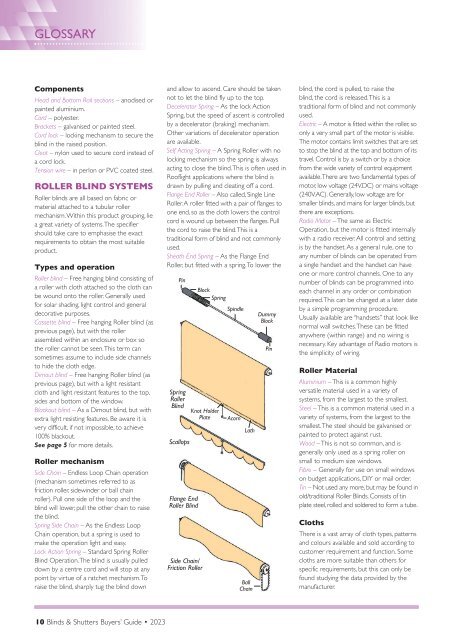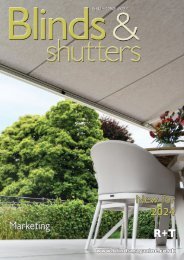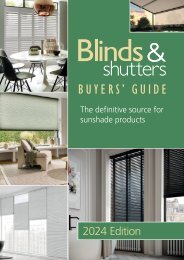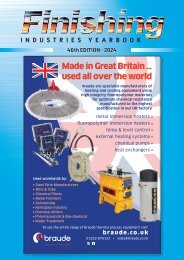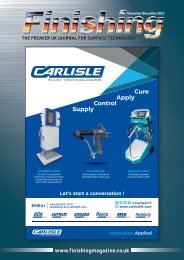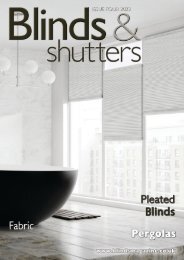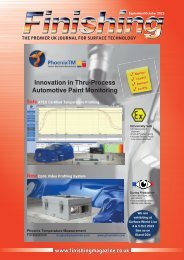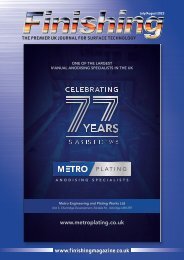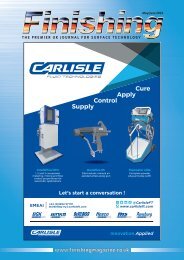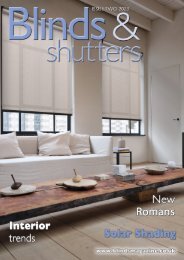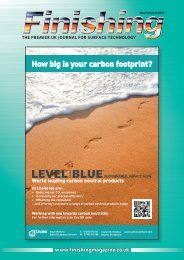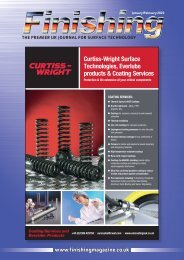Blinds & Shutters Buyers Guide 2023
Welcome to the Blinds & Shutters Buyers’ Guide 2023 the only UK directory for blinds, shutters, awnings and grilles. This is the essential guide for manufacturers, retailers and specifiers such as architects and designers, to source components and finished products. This edition of the Buyers’ Guide contains useful and practical information, such as the revised Glossary that starts on page 5. In the Year in Review starting on page 26, we take a look at the issues that dominated the headlines. On page 28 the Smart Buildings Show 2022, proved to be the biggest and best yet! Features on new products start on page 30, whilst the BSI revised some of the Relevant Standards, and this section can be found on page 113. The A-Z Section and Buyers’ Guide Section provides information relating to 450 businesses and 50 different product types. We hope that you find this year’s directory an invaluable aid to sourcing suppliers to provide the solution to your specific needs.
Welcome to the Blinds & Shutters Buyers’ Guide 2023 the only UK directory for blinds, shutters, awnings and grilles. This is the essential guide for manufacturers, retailers and specifiers such as architects and designers, to source components and finished products.
This edition of the Buyers’ Guide contains useful and practical information, such as the revised Glossary that starts on page 5. In the Year in Review starting on page 26, we take a look at the issues that dominated the headlines. On page 28 the Smart Buildings Show 2022, proved to be the biggest and best yet! Features on new products start on page 30, whilst the BSI revised some of the Relevant Standards, and this section can be found on page 113.
The A-Z Section and Buyers’ Guide Section provides information relating to 450 businesses and 50 different product types.
We hope that you find this year’s directory an invaluable aid to sourcing suppliers to provide the solution to your specific needs.
Create successful ePaper yourself
Turn your PDF publications into a flip-book with our unique Google optimized e-Paper software.
GLOSSARY<br />
Components<br />
Head and Bottom Rail sections – anodised or<br />
painted aluminium.<br />
Cord – polyester.<br />
Brackets – galvanised or painted steel.<br />
Cord lock – locking mechanism to secure the<br />
blind in the raised position.<br />
Cleat – nylon used to secure cord instead of<br />
a cord lock.<br />
Tension wire – in perlon or PVC coated steel.<br />
ROLLER BLIND SYSTEMS<br />
Roller blinds are all based on fabric or<br />
material attached to a tubular roller<br />
mechanism. Within this product grouping, lie<br />
a great variety of systems. The specifier<br />
should take care to emphasise the exact<br />
requirements to obtain the most suitable<br />
product.<br />
Types and operation<br />
Roller blind – Free hanging blind consisting of<br />
a roller with cloth attached so the cloth can<br />
be wound onto the roller. Generally used<br />
for solar shading, light control and general<br />
decorative purposes.<br />
Cassette blind – Free hanging Roller blind (as<br />
previous page), but with the roller<br />
assembled within an enclosure or box so<br />
the roller cannot be seen. This term can<br />
sometimes assume to include side channels<br />
to hide the cloth edge.<br />
Dimout blind – Free hanging Roller blind (as<br />
previous page), but with a light resistant<br />
cloth and light resistant features to the top,<br />
sides and bottom of the window.<br />
Blackout blind – As a Dimout blind, but with<br />
extra light resisting features. Be aware it is<br />
very difficult, if not impossible, to achieve<br />
100% blackout.<br />
See page 5 for more details.<br />
Roller mechanism<br />
Side Chain – Endless Loop Chain operation<br />
(mechanism sometimes referred to as<br />
friction roller, sidewinder or ball chain<br />
roller). Pull one side of the loop and the<br />
blind will lower, pull the other chain to raise<br />
the blind.<br />
Spring Side Chain – As the Endless Loop<br />
Chain operation, but a spring is used to<br />
make the operation light and easy.<br />
Lock Action Spring – Standard Spring Roller<br />
Blind Operation. The blind is usually pulled<br />
down by a centre cord and will stop at any<br />
point by virtue of a ratchet mechanism. To<br />
raise the blind, sharply tug the blind down<br />
and allow to ascend. Care should be taken<br />
not to let the blind fly up to the top.<br />
Decelerator Spring – As the lock Action<br />
Spring, but the speed of ascent is controlled<br />
by a decelerator (braking) mechanism.<br />
Other variations of decelerator operation<br />
are available.<br />
Self Acting Spring – A Spring Roller with no<br />
locking mechanism so the spring is always<br />
acting to close the blind. This is often used in<br />
Rooflight applications where the blind is<br />
drawn by pulling and cleating off a cord.<br />
Flange End Roller – Also called, Single Line<br />
Roller. A roller fitted with a pair of flanges to<br />
one end, so as the cloth lowers the control<br />
cord is wound up between the flanges. Pull<br />
the cord to raise the blind. This is a<br />
traditional form of blind and not commonly<br />
used.<br />
Sheath End Spring – As the Flange End<br />
Roller, but fitted with a spring. To lower the<br />
Pin<br />
Spring<br />
Roller<br />
Blind<br />
Scallops<br />
Flange End<br />
Roller Blind<br />
Side Chain/<br />
Friction Roller<br />
Block<br />
Spring<br />
Knot Holder<br />
Plate<br />
Spindle<br />
Acorn<br />
Lath<br />
Ball<br />
Chain<br />
Dummy<br />
Block<br />
Pin<br />
blind, the cord is pulled, to raise the<br />
blind, the cord is released. This is a<br />
traditional form of blind and not commonly<br />
used.<br />
Electric – A motor is fitted within the roller, so<br />
only a very small part of the motor is visible.<br />
The motor contains limit switches that are set<br />
to stop the blind at the top and bottom of its<br />
travel. Control is by a switch or by a choice<br />
from the wide variety of control equipment<br />
available. There are two fundamental types of<br />
motor, low voltage (24V.DC) or mains voltage<br />
(240V.AC). Generally, low voltage are for<br />
smaller blinds, and mains for larger blinds, but<br />
there are exceptions.<br />
Radio Motor – The same as Electric<br />
Operation, but the motor is fitted internally<br />
with a radio receiver. All control and setting<br />
is by the handset. As a general rule, one to<br />
any number of blinds can be operated from<br />
a single handset and the handset can have<br />
one or more control channels. One to any<br />
number of blinds can be programmed into<br />
each channel in any order or combination<br />
required. This can be changed at a later date<br />
by a simple programming procedure.<br />
Usually available are “handsets” that look like<br />
normal wall switches. These can be fitted<br />
anywhere (within range) and no wiring is<br />
necessary. Key advantage of Radio motors is<br />
the simplicity of wiring.<br />
Roller Material<br />
Aluminium – This is a common highly<br />
versatile material used in a variety of<br />
systems, from the largest to the smallest.<br />
Steel – This is a common material used in a<br />
variety of systems, from the largest to the<br />
smallest. The steel should be galvanised or<br />
painted to protect against rust.<br />
Wood – This is not so common, and is<br />
generally only used as a spring roller on<br />
small to medium size windows.<br />
Fibre – Generally for use on small windows<br />
on budget applications, DIY or mail order.<br />
Tin – Not used any more, but may be found in<br />
old/traditional Roller <strong>Blinds</strong>. Consists of tin<br />
plate steel, rolled and soldered to form a tube.<br />
Cloths<br />
There is a vast array of cloth types, patterns<br />
and colours available and sold according to<br />
customer requirement and function. Some<br />
cloths are more suitable than others for<br />
specific requirements, but this can only be<br />
found studying the data provided by the<br />
manufacturer.<br />
10 <strong>Blinds</strong> & <strong>Shutters</strong> <strong>Buyers</strong>’ <strong>Guide</strong> • <strong>2023</strong>


